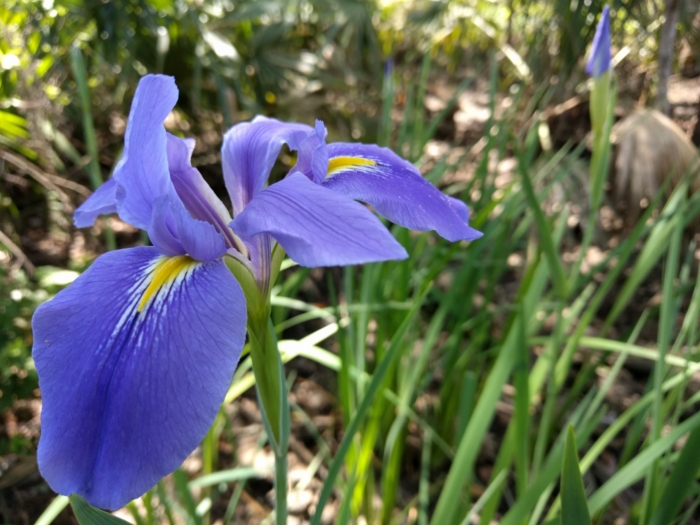Giant Blue Iris
(Iris giganticaerulea)
Giant Blue Iris (Iris giganticaerulea)
/
/

Irvin Louque
CC BY 4.0
Image By:
Irvin Louque
Recorded By:
Copyright:
CC BY 4.0
Copyright Notice:
Photo by: Irvin Louque | License Type: CC BY 4.0 | License URL: http://creativecommons.org/licenses/by/4.0/ | Rights Holder: Irvin Louque | Publisher: iNaturalist | Date Created: 2017-03-14T12:24:33-07:00 |




















Estimated Native Range
Summary
Iris giganticaerulea, commonly known as Giant Blue Iris, is an evergreen perennial herb native to the coastal plains and marsh areas of the Southeastern United States, particularly Louisiana. This species thrives in wetland habitats such as swamps and along the edges of ponds and streams. It features long, bright green leaves and very tall stems that can grow between 28–71 inches (70–180 cm) tall. The plant produces one or two musky fragrant flowers per stem in a range of blue shades, including pale, bright, dark, lavender, and violet, or rarely white. The flowers are generally 5 to 6 inches (13 to 15 cm) across and bloom from early to mid-spring, offering a showy display.
The Giant Blue Iris is valued for its striking height, fragrant flowers, and ability to form large clumps or colonies, making it an excellent choice for water gardens, rain gardens, and naturalized areas. It is also used for erosion control along waterways. This iris requires moist, acidic soils with a pH level of 6.5, rich in organic matter and high fertility. It is essential to maintain moisture during the leaf growth period from late autumn to spring. Dividing the rhizomes is the preferred method of propagation, ideally in early autumn or spring when the plant is dormant. Fertilization can be done in late winter before flowering. While the seeds can be slow to germinate and take several years to flower, they offer a 50% germination rate. The plant is hardy to USDA Zone 7 to 11, with some protection needed in Zones 5 and 6 during winter.CC BY-SA 4.0
The Giant Blue Iris is valued for its striking height, fragrant flowers, and ability to form large clumps or colonies, making it an excellent choice for water gardens, rain gardens, and naturalized areas. It is also used for erosion control along waterways. This iris requires moist, acidic soils with a pH level of 6.5, rich in organic matter and high fertility. It is essential to maintain moisture during the leaf growth period from late autumn to spring. Dividing the rhizomes is the preferred method of propagation, ideally in early autumn or spring when the plant is dormant. Fertilization can be done in late winter before flowering. While the seeds can be slow to germinate and take several years to flower, they offer a 50% germination rate. The plant is hardy to USDA Zone 7 to 11, with some protection needed in Zones 5 and 6 during winter.CC BY-SA 4.0
Plant Description
- Plant Type: Herb
- Height: 3-5 feet
- Width: 0.4-0.9 feet
- Growth Rate: Moderate
- Flower Color: Blue, Pink, Purple
- Flowering Season: Spring
- Leaf Retention: Evergreen
Growth Requirements
- Sun: Full Sun, Part Shade
- Water: High
- Drainage: Wet, Slow
Common Uses
Bee Garden, Bird Garden, Butterfly Garden, Deer Resistant, Hummingbird Garden, Low Maintenance, Rabbit Resistant, Showy Flowers, Water Garden
Natural Habitat
Coastal plains and marsh areas of the Southeastern United States, particularly Louisiana
Other Names
Common Names:
Scientific Names: , Iris giganticaerulea, Iris hexagona var. giganticaerulea, Iris fluviatilis, Iris miraculosa, Iris aurilinea, Iris citricristata, Iris elephantina, Iris giganticaerulea f. miraculosa, Iris venulosa
GBIF Accepted Name: Iris giganticaerulea Small